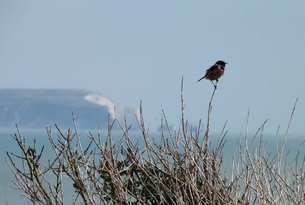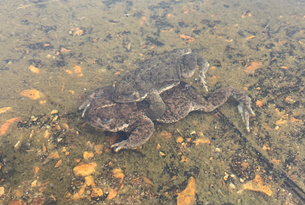Dog trail-stop 8
Stop eight on the Hengistbury Dog Walking Trail
Stop 8 - West Field
Meadows
Did you know that wildflowers aren’t the only thing great for supporting our pollinators? Meadows like this provide lots of food and cover for our vital pollinators, from an assortment of grasses alongside wildflowers.Take a moment to look out at the meadow and see just how beautiful these grasses can be when allowed to grow long and sway in the breeze! Can you hear bees? Or see crickets or grasshoppers? Are the birds searching for food and cover in these grasses? Or perhaps you are visiting in Winter time, can you see the areas of scrub providing a place for the wonderful wildlife such as Stonechats and Skylarks?

And of course, these long grasses can provide a great fun place for our dogs too! With lots of areas to smell and explore, just be careful you don’t disturb any wildlife, and that you check your pups over for grass seeds and ticks after exploring.
Natterjack Toads

These fenced areas are for our herd of native breed Shetland cattle to maintain the scrub in this sand dune/grassland habitat. And within one of these fenced areas, are two artificial ponds created for another of our special species here at Hengistbury Head Nature Reserve... Natterjack Toads!
Natterjack Toads are found in just a few coastal locations in the UK; this toad prefers shallow pools on sand dunes, heathlands and marshes.Natterjacks are a European Protected Species,which means it is an offence to kill, capture or disturb these creatures. They are very distinctive, with the yellow stripe down their olive-green back - even as toadlets!
They lay their spawn in strings in warm, shallow water - one string can contain up to 4,000 eggs! Toadlets take up to 6-8 weeks to develop from spawn and favour the edge of the ponds rather than the depths. As a nocturnal species, they spend the day in burrows and come out at night between April-July to breed in the shallow ponds here. The males "sing" in raspy tones to attract females which can be heard up to a mile away.
To watch YouTube videos on this site, you need to accept YouTube and Video cookies and then refresh the page.
The artificial ponds around Hengistbury were installed to help keep them safe, and we can also reduce our risk of disturbance by keeping ourselves (and our pups) to the paths.
Find out more about bringing your dog to Hengistbury Head